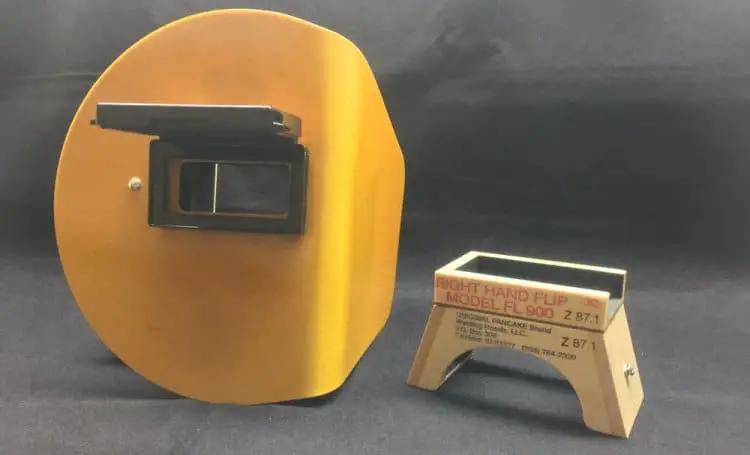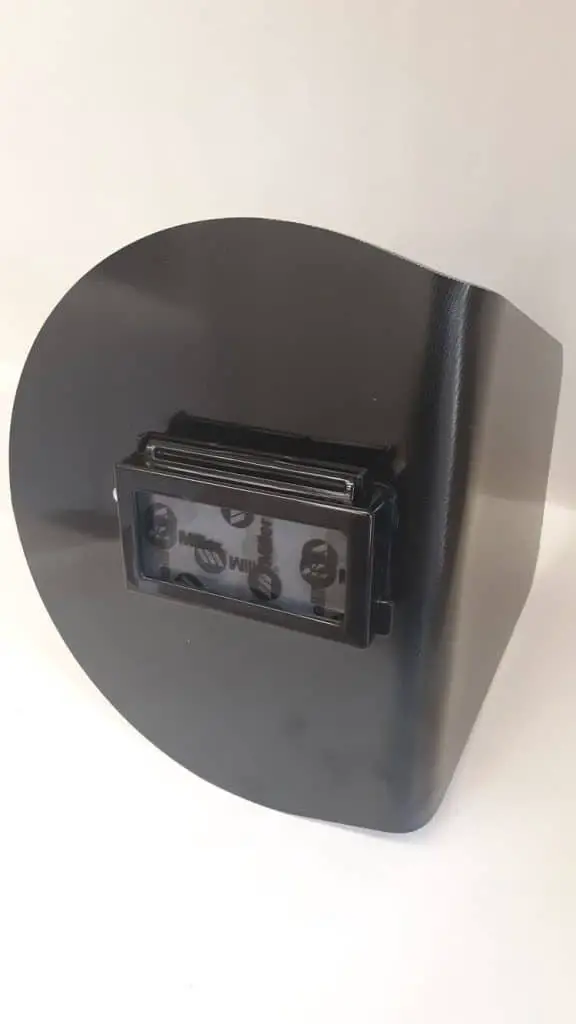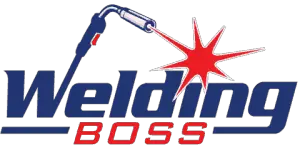This post contains affiliate links to products, services, or education. We may receive a commission for purchases made through links.

The pancake welding hood is rapidly finding favor with many professional welders, especially those who work outdoors where sunshine glare on the inside of the traditional welding helmet can cause problems. There are other benefits, not the least of which is comfort.
Benefits of Pancake Welding Hood. Pancake welding hoods offer both the professional and the hobby welder several benefits:
- Comfort
- Protection
- Weight
- Glare Reduction
The four benefits listed above are the most common answers you get when you ask professional welders about their choice of welding hoods. Asking a few more questions will quickly get you a much better understanding of why these four benefits are so important to the men and women who wear welding hoods for hours each day.
Check out our favorite pancake welding hood on Amazon here.
What Is a Pancake Welding Hood?

A pancake welding hood is a variation on the traditional pipeliner welding hood that first appeared almost 100 years ago. Source: History of Welding Helmet
For many years, the traditional protection for welders face and eyes was a heavy welder mask or hood that wrapped around the face. In some cases, the hoods or masks extended up almost over the top of the head and under the chin. The mask or hood design holds a glass filter that protects the welder’s eyes from the intense light of the welding arc.
Early pipeliner masks made of metal had serious drawbacks. The greatest problem was the metal itself. Working with high currents and high amperages is extremely dangerous. Accidently inserting the metal mask into the current loop creates a deadly situation for the welder.
During World War II, welding technology made many advances. The welder’s equipment followed suit. During this time, the use of other materials for welding hoods came into use. Today, fiberglass and some metal/plastic combinations dominate the market.
Fun Fact! During World War II, advances in welding methods and equipment allowed welded joints in ships that previously had to be made by riveting. The process of welding vs. riveting allowed ship production at a rate that was unprecedented. The SS Robert E. Peary was constructed in 1942 in 4 days, 15 hours, and 27 minutes. Courtesy of Felling Trailers
However, the overall design of the traditional pipeliner welding helmet did not change significantly. The overall shape remained fairly consistent, and the mechanisms for wearing the welding mask, such as an adjustable headband, flip-up swivels, and quick change lens holders, were the only real updates to the design.
Traditional pipeliner style helmets are still widely used and popular in welding shops around the country. Many welders customize their helmets with paint schemes to create an individual identity that is recognizable in the work environment when the welder’s face is well hidden behind the mask.
Most fabrication welders work indoors under controlled lighting, and the work is performed on jigs or tables at a convenient height for the welder. Welders working on job sites outdoors or encountering unusual positions, soon found several problems while using the traditional pipeliner style of helmet.
The traditional style helmets bulk and size posed problems when moving around tight spaces, working upside down, or hanging over an edge. The shape of most traditional welding masks inhibits air movement around the face, making them hot and humid.
Fun Fact! Traditional welding helmets are often classified into six categories
- Passive Helmets
- Auto-darkening helmets
- Solar-powered lens
- Battery-powered helmet
- Fixed shade lens
- Variable shade lens
For more detailed information about the features and advantages of these styles of helmets, visit WeldingChamps
A big problem for welders working outdoors is the sun. In the wrong position, the sunlight can strike the inside of the glass filter and glare back into the welder’s face, momentarily blinding them and making welding difficult, if not impossible.
Welders, being innovative by nature, began looking for solutions and alternatives to these problems. From that search, eventually came the design that would evolve into what we call the pancake hood.
The Pancake Welding Hood Concept
The concept for the pancake welding hood first appeared on some job sites shortly after World War II. There are several stories on the internet relating to the “true” story of who designed and where the first pancake helmet appeared. The important thing to understand is that the first pancake welding hood designs intended to solve several very specific problems on a welding job site.
The one issue that seems to be the driving force behind the development of the pancake welding hood is the problem of sunlight entering the traditional pipeliner helmet from behind and creating glare that effectively blinded the welder. Glare suddenly blinding a welder while running a weld caused problems, especially in situations where weld quality is critical.
Many welders resorted to the old method of wearing gas welding goggles with a makeshift means of attaching an arc welding filter. They would wear a welding sock or hood over their heads to protect themselves from the slag and UV light produced by the arc of the welding rods.
The pancake welding hood grew out of the realization that the goggle concept was a valid response. The goggles offered superior eye protection and prevented glare from being a problem no matter what angle the sun. Finally, someone put together the first of what we now know as the pancake welding hood.
What Makes it a Pancake Welding Hood?
If you are not familiar with pancake welding hoods, you will have no problem understanding how the name evolved once you see one. Instead of a large full wrap-around helmet style protection, the pancake welding hood is s simple disk of protective material, large enough in diameter to protect the welder’s face.
The protective disk has another piece of protective material attached to one side that protects the welder’s face and head from the hot metal and UV light. If a welder is right-handed, the side shield is typically placed on the left side of the front disk. This feature of the pancake welding hood requires that the welder order the proper configuration for their welding style.
It is the box inside the pancake helmet that is the biggest difference. Many variations of goggles and surrounds were tried as the pancake welding hood developed. Someone finally came up with the design that is found across the industry now. Balsa wood, a very strong and light wood, is used to construct a box inside the hood on the back of the protective disk. This box holds the glass welding filter and roughly fits the contours of the welder’s face.
Standard practice is to use sandpaper to slowly remove material on the inside of the box to perfectly fit the box to the contours of the welder’s face. By all accounts, this type of fitting makes the pancake welding hood extremely comfortable to wear for long periods. Comfort is a big plus for welders who wear their hoods for long periods during a workday.
Early pancake welding hoods were somewhat cumbersome to use. Having to remove the mask between welds could be time-consuming and often caused undue wear and tear on the soft balsa wood of the filter box. The invention of the auto-darkening welding filter solved these problems.
Fun Fact! The first auto-darkening welding lens was invented by a Swedish manufacturing company
The unique design created to solve many problems has made the pancake welding hood a mainstay in the welding industry. Many pancake designs are even OSHA approved, making them acceptable on almost all job sites.
The Comfort Concept
Welding is, by nature, an uncomfortable occupation. Welders work in hostile environments or large work areas that are not heated or cooled, are noisy, and dangerous. For these reasons, welders are always on the lookout for anything that can add to their comfort while at work. Pancake hoods are one of those solutions.
Pancake hoods are usually lighter than the traditional pipeliner hood. The lighter weight of the pancake hood reduces the strain on the neck and shoulders. Because the pancake hood is more open, air circulation around the face and neck is usually much better, leading to a cooler work environment. One other comfort issue mentioned by some welders on an industry forum is the issue of the headband.
Traditional welding hoods have a heavier adjustable headband. The weight of the helmet itself and the swivel system that allows the hood to be raised over the head to allow the welder to see the work not only adds to the weight of the whole helmet, it often is a source of irritation around the head. Many welders find the required tightness of the headband to accommodate the movement of the helmet to be uncomfortable. Source, Reddit/Welding
On the other hand, pancake welding hoods often have an elastic headband. Using an elastic headband is possible due to the lighter weight of the whole pancake hood and the way the balsa wood box fits on the face providing a stable support platform. With the addition of an auto-darkening lens, the need to constantly remove and replace the hood disappears.
Overall, comfort is a major safety issue in any workplace. Safety gear that is comfortable, easy to wear, and easy operate usually leads to workers being more consistent in their use of the safety equipment.
The Safety Issue
Traditional style welding hoods, while providing adequate
protection from welding splatter and the UV light and heat, have some shortcomings. Many welders make a habit of wearing safety glasses under the traditional hood as further protections against flying splatter or slag.Pancake welding hoods eliminate the need to wear safety glasses because the balsa box, when properly fitted, provides a tight seal to the welder’s face. Also, with some adjustments to the balsa box, a welder can continue to wear his or her prescription glasses with no loss of protection or comfort.
There have been some questions about job site safety and requirements for OSHA approval on pancake welding hoods. Some pancake hoods carry the ANSI Z-871 approval. A search of the manufacturer’s websites reveals that most of the major manufacturers do have both OSHA and ANSI approvals. Source: Original Pancake Brand Welding Hoods, LLC
Of course, safety equipment, including welding hoods are only effective if they are properly worn and properly fitted. An uncomfortable hood is likely to be set aside or worn only when necessary. Failure to wear proper safety equipment is especially true of hobby and home welders. Professional welders are well aware of the long health issues associated with welding without approved safety equipment.
The most common type of injury while welding is burns. These burn injuries include both radiation burns from the intense heat and UV light generated by arc welding, the contact burns from hot slag or splatter, and burn injuries to the eyes caused by the intense light and UV radiation. This type of burn can cause long term catastrophic damage to a welder’s vision.
The number one cause of injuries to welders is the failure to wear proper safety equipment. Source: IOC Welding Supplies
Weight and Materials
Weight is an issue with conventional pipeliner style welding hoods. Even the newer materials such as plastic and fiberglass become heavy when built to meet OSHA and ANSI standards. Weight issues often lead welders to modify their equipment to try and lighten them.
These modifications often involve cutting down the helmet to remove material. Unfortunately, removing material from the perimeter of the helmet also reduces the safety factor provided. Less protective wrap around means a greater chance of slag, splatter, or UV light entering the facial area.
Some manufacturers are making further attempts to lighten the traditional style pipeliner helmet by using newer lighter materials. Aluminum and carbon fiber are two of the newest entries. However, both have significant problems. Both materials, aluminum and carbon fiber, conduct electricity.
Many forms of welding require large currents and amperages of electricity to produce the arc that performs the welding work. Anytime welders are using such equipment, the potential for an electrical accident is present. Conductivity is of particular concern if the helmet you are wearing has the potential to become part of the electrical circuit.
By and large, pancake welding hoods avoid these potential problems by using non-conductive materials in the construction of the hood. The fact that the major contact point on the body is the face box is another advantage. The box, made of balsa wood, is much less conductive than many other materials used in traditional pipeliner style helmets.
Fun Fact! For small welders that run on 115 volts can produce up to 140 amps and will weld up to 1/4″ thick steel. For 220 volt welders, you can expect around 200 amps and weld up to 1/2″ material. Courtesy of WeldersLab
The issue of conductivity is heightened for hobby or home welders who are often concerned with the cost of their safety equipment but are also not as aware of some of the safety issues of welding. Not surprisingly, there are more injuries in home and hobby welding than in professional welding shops on a percentage basis. Source Centers for Disease Control
The Glare Issue
Perhaps the most cited reason by professional welders for using a pancake welding hood is the issue of glare inside the helmet, especially while working outside. The design of traditional pipeliner style hoods allows sunlight to enter the back of the hood and create glare on the inside of the protective filter lens.
This glare can be both a safety issue and a work quality issue. Glare can lead to accidents due to the reaction of the welder to a sudden intense glint of sunlight. Falls and other injury reports due to this kind of reaction dominate the data. Source: United States Department of Labor
Quality of work can also be affected in much the same way. A welder, suddenly faced with a glint or glare on the inside of the helmet may not be able to control the welding equipment. A sudden reaction glare or glint can lead to bad welds or misplaced welds that must be ground out and redone.
The reduction or elimination of glare is why the pancake welding hood is so popular among welders who work outside. The design of the pancake hood with the fitted balsa wood box against the face protects the inside of the filter lens and prevents glare or glint.
What Are The Benefits of a Pancake Welding Hood?
Four benefits can explain the popularity of the pancake welding hood. The four benefits, comfort, protection, weight, and glare reduction, are easy to understand and explain the reasons many welders have adopted the pancake welding helmet as their go-to piece of protective equipment on the job. Many explain that the ease of use, the lightweight, and the elimination of glare inside the hood make the decision an easy one for them. Unfortunately, many home and hobby welders are unfamiliar with the pancake welding hood. Many accidents and injuries associated with welding among home and hobby welders might well be eliminated or prevented if the pancake welding hood was more widely known and understood.
